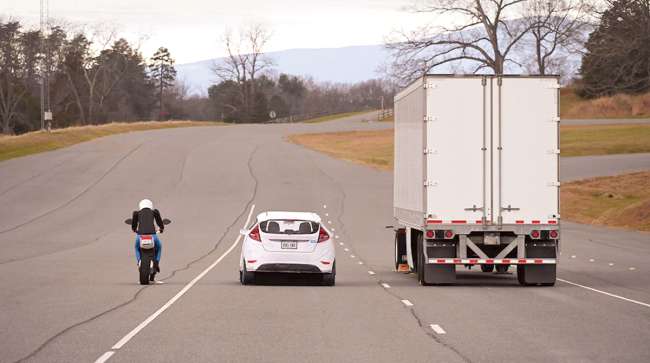Staff Reporter
Car Safety Systems Less Effective in Detecting Trucks

[Stay on top of transportation news: Get TTNews in your inbox.]
Better front crash prevention technology in passenger cars could prevent 5,500 rear-end accidents with medium and heavy trucks, according to a new Insurance Institute for Highway Safety report.
The December study, called “Are Front Crash Prevention Systems Less Effective at Preventing Rear-end Crashes where Trucks and Motorcycles Are Struck?,” reviewed data from over 160,000 rear-end crashes in which a passenger vehicle with/without forward collision warning (FCW) and automatic emergency braking (AEB) systems hit another passenger vehicle, a medium/heavy truck or a motorcycle.
Most front crash prevention systems include FCW, which warns drivers when a rear-end crash is imminent, and AEB that slams on the brakes if the driver fails to respond in time.
The report found that passenger vehicles equipped with AEB and FCW technology are 53% less likely to rear-end other passenger vehicles. Yet, that crash avoidance rate drops to 41% to deter striking motorcycles. The rate dips even lower to 38% to prevent cars from slamming into the backs of medium/heavy trucks.
Current front crash prevention systems could prevent hundreds of rear-end crashes with motorcyclists each year if they detected them as well as other passenger vehicles. https://t.co/NvIaMRv0Oj pic.twitter.com/ZV17G0ZNvp — IIHS (@IIHS_autosafety) January 2, 2024
Jessica Cicchino, IIHS vice president of research, characterized the safety results offered by the front crash prevention technology as being “impressive for all vehicle types, but the safety benefits could be even larger if front crash prevention systems were as good at mitigating and preventing crashes with big trucks and motorcycles as they are with cars.”
The study stated that if all passenger vehicles were equipped with FCW and AEB that were as effective in crashes striking a truck or motorcycle as they are in crashes with another passenger vehicle, “over 5,500 additional crashes with medium/heavy trucks and 500 with motorcycles could potentially be prevented annually in the United States.”
Furthermore, the report noted that rear-end crashes where a medium/heavy truck or a motorcycle is struck are more often deadly. An earlier IIHS study found that a medium or heavy truck or a motorcycle is struck by a passenger vehicle in about 43% of fatal rear-end crashes.
Given the recent findings, the report stated that IIHS is updating its front crash prevention testing program to evaluate if systems can detect a tractor-trailer or avoid striking a stationary motorcycle-surrogate target at various rates of speed.
Front crash prevention performance “that avoids rear-end crashes with motorcycles and medium/heavy trucks can be added to the toolbox of countermeasures to prevent or mitigate the severity of these crashes,” the report contended.
The institute also suggested that extending front crash prevention testing in consumer information programs to include motorcycle and truck targets “could encourage auto manufacturers to improve performance in these crash scenarios.”
This year, IIHS plans to publish updated ratings in a new vehicle-to-vehicle front crash prevention evaluation to ensure systems “are equally adept at preventing crashes with large trucks and motorcycles and to address the large portion of rear-end crashes that happen at higher speeds.”
Want more news? Listen to today's daily briefing below or go here for more info:


